ignition Citroen NEMO 2008.5 1.G Owner's Guide
[x] Cancel search | Manufacturer: CITROEN, Model Year: 2008.5, Model line: NEMO, Model: Citroen NEMO 2008.5 1.GPages: 140, PDF Size: 2.21 MB
Page 91 of 140
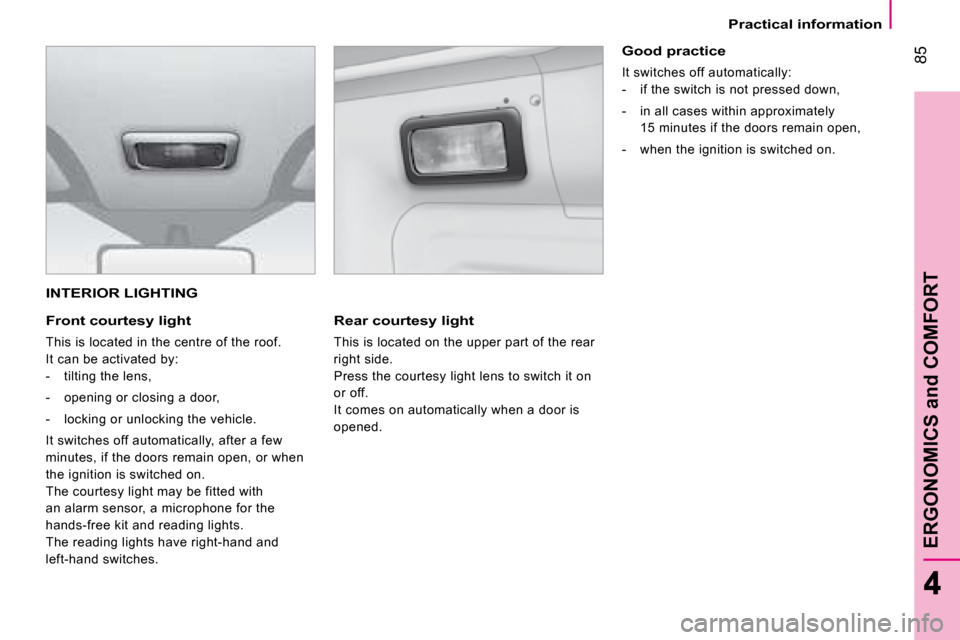
85
ERGONOMICS and COMFORT
Practical information
INTERIOR LIGHTING
Front courtesy light
This is located in the centre of the roof.
It can be activated by:
- tilting the lens,
- opening or closing a door,
- locking or unlocking the vehicle.
It switches off automatically, after a few
minutes, if the doors remain open, or when
the ignition is switched on.
The courtesy light may be fitted with
an alarm sensor, a microphone for the
hands-free kit and reading lights.
The reading lights have right-hand and
left-hand switches.
Rear courtesy light
This is located on the upper part of the rear
right side.
Press the courtesy light lens to switch it on
or off.
It comes on automatically when a door is
opened.
Good practice
It switches off automatically:
- if the switch is not pressed down,
- in all cases within approximately 15 minutes if the doors remain open,
- when the ignition is switched on.
Page 92 of 140
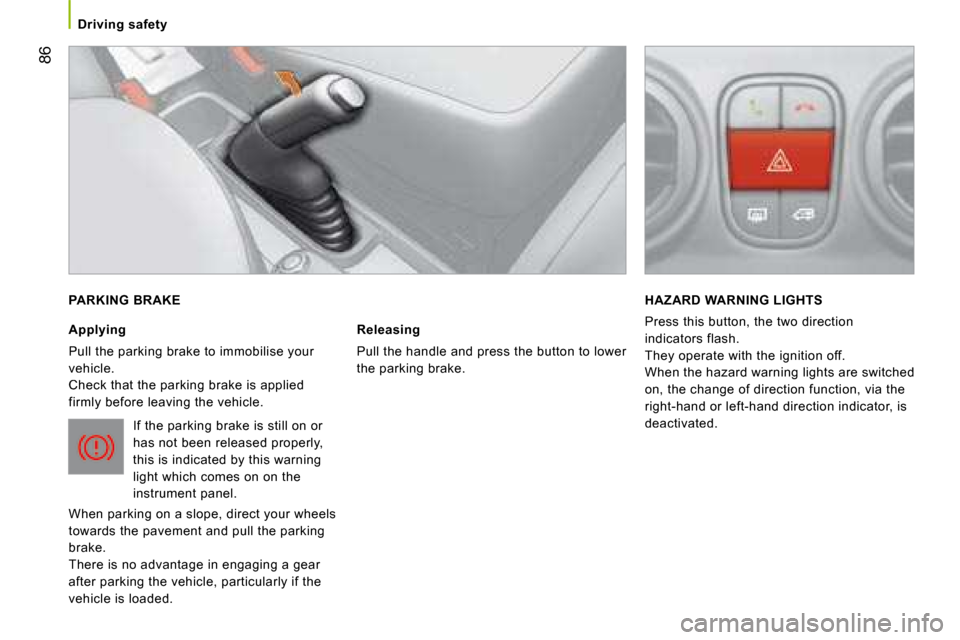
86
Driving safety
PARKING BRAKE
Applying
Pull the parking brake to immobilise your
vehicle.
Check that the parking brake is applied
firmly before leaving the vehicle.
If the parking brake is still on or
has not been released properly,
this is indicated by this warning
light which comes on on the
instrument panel.
When parking on a slope, direct your wheels
towards the pavement and pull the parking
brake.
There is no advantage in engaging a gear
after parking the vehicle, particularly if the
vehicle is loaded. Releasing
Pull the handle and press the button to lower
the parking brake.
HAZARD WARNING LIGHTS
Press this button, the two direction
indicators flash.
They operate with the ignition off.
When the hazard warning lights are switched
on, the change of direction function, via the
right-hand or left-hand direction indicator, is
deactivated.
Page 94 of 140
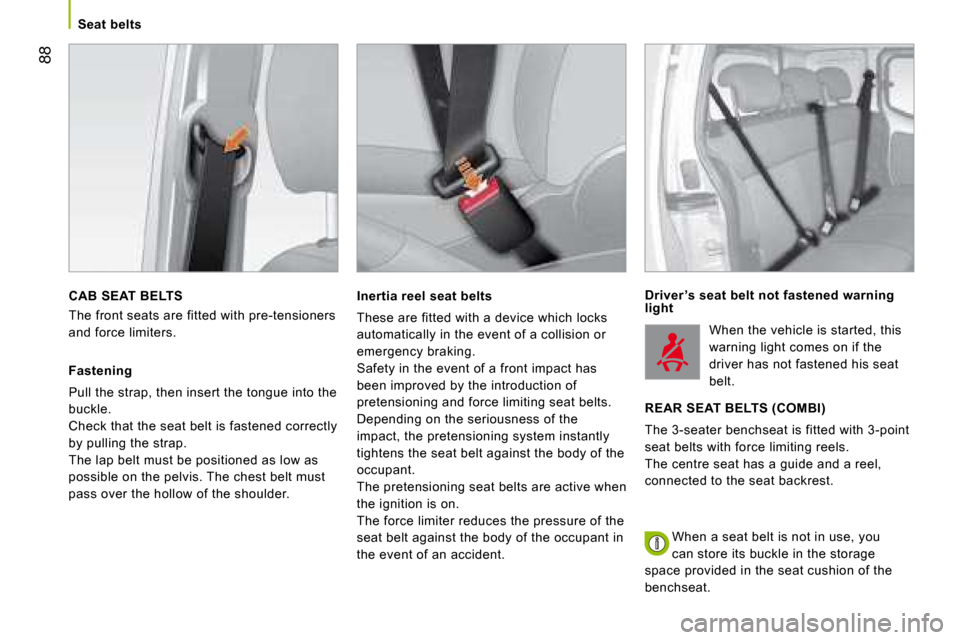
88
Seat belts
CAB SEAT BELTS
The front seats are fitted with pre-tensioners
and force limiters.
Fastening
Pull the strap, then insert the tongue into the
buckle.
Check that the seat belt is fastened correctly
by pulling the strap.
The lap belt must be positioned as low as
possible on the pelvis. The chest belt must
pass over the hollow of the shoulder.
Inertia reel seat belts
These are fitted with a device which locks
automatically in the event of a collision or
emergency braking.
Safety in the event of a front impact has
been improved by the introduction of
pretensioning and force limiting seat belts.
Depending on the seriousness of the
impact, the pretensioning system instantly
tightens the seat belt against the body of the
occupant.
The pretensioning seat belts are active when
the ignition is on.
The force limiter reduces the pressure of the
seat belt against the body of the occupant in
the event of an accident.
Driver ’s seat belt not fastened warning
light
When the vehicle is started, this
warning light comes on if the
driver has not fastened his seat
belt.
REAR SEAT BELTS (COMBI)
The 3-seater benchseat is fitted with 3-point
seat belts with force limiting reels.
The centre seat has a guide and a reel,
connected to the seat backrest.
When a seat belt is not in use, you
can store its buckle in the storage
space provided in the seat cushion of the
benchseat.
Page 95 of 140
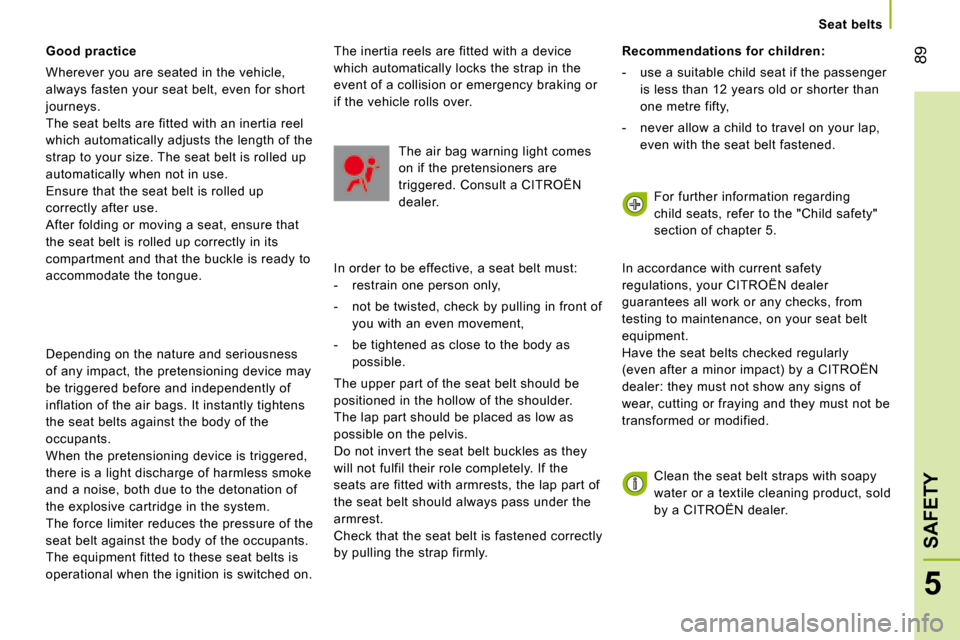
89
5
SAFETY
Seat belts
Good practice
Wherever you are seated in the vehicle,
always fasten your seat belt, even for short
journeys.
The seat belts are fitted with an inertia reel
which automatically adjusts the length of the
strap to your size. The seat belt is rolled up
automatically when not in use.
Ensure that the seat belt is rolled up
correctly after use.
After folding or moving a seat, ensure that
the seat belt is rolled up correctly in its
compartment and that the buckle is ready to
accommodate the tongue.
The inertia reels are fitted with a device
which automatically locks the strap in the
event of a collision or emergency braking or
if the vehicle rolls over.
The air bag warning light comes
on if the pretensioners are
triggered. Consult a CITROËN
dealer .
Depending on the nature and seriousness
of any impact, the pretensioning device may
be triggered before and independently of
inflation of the air bags. It instantly tightens
the seat belts against the body of the
occupants.
When the pretensioning device is triggered,
there is a light discharge of harmless smoke
and a noise, both due to the detonation of
the explosive cartridge in the system.
The force limiter reduces the pressure of the
seat belt against the body of the occupants.
The equipment fitted to these seat belts is
operational when the ignition is switched on.
In order to be effective, a seat belt must:
- restrain one person only,
- not be twisted, check by pulling in front of
you with an even movement,
- be tightened as close to the body as
possible.
The upper part of the seat belt should be
positioned in the hollow of the shoulder.
The lap part should be placed as low as
possible on the pelvis.
Do not invert the seat belt buckles as they
will not fulfil their role completely. If the
seats are fitted with armrests, the lap part of
the seat belt should always pass under the
armrest.
Check that the seat belt is fastened correctly
by pulling the strap firmly.
Recommendations for children:
- use a suitable child seat if the passenger
is less than 12 years old or shorter than
one metre fifty,
- never allow a child to travel on your lap,
even with the seat belt fastened.
For further information regarding
child seats, refer to the "Child safety"
section of chapter 5.
In accordance with current safety
regulations, your CITROËN dealer
guarantees all work or any checks, from
testing to maintenance, on your seat belt
equipment.
Have the seat belts checked regularly
(even after a minor impact) by a CITROËN
dealer : they must not show any signs of
wear, cutting or fraying and they must not be
transformed or modified.
Clean the seat belt straps with soapy
water or a textile cleaning product, sold
by a CITROËN dealer .
Page 96 of 140
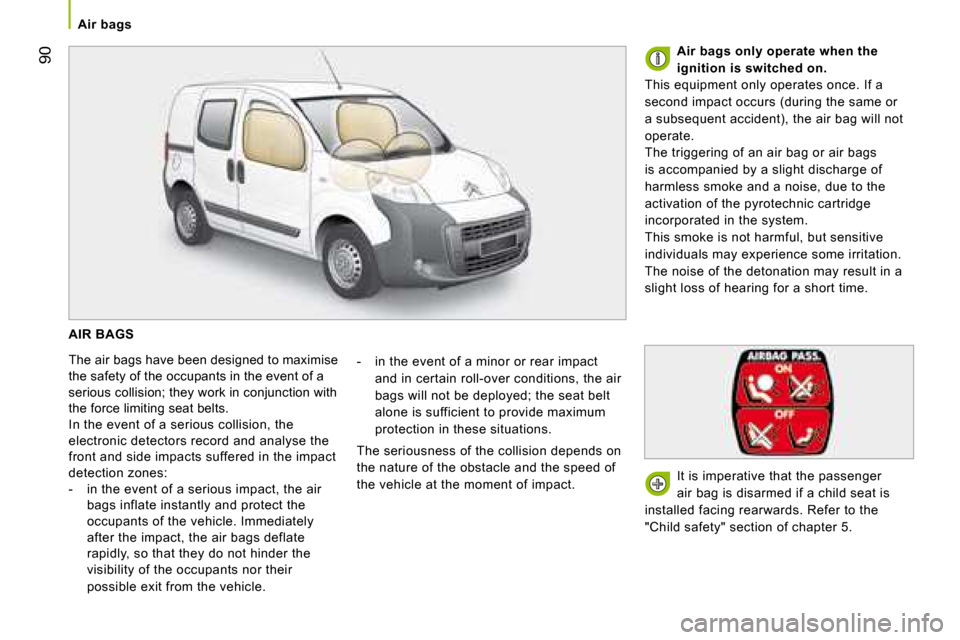
90
Air bags
AIR BAGS
The air bags have been designed to maximise the safety of the occupants in the event of a serious collision; they work in conjunction with the force limiting seat belts. In the event of a serious collision, the electronic detectors record and analyse the front and side impacts suffered in the impact detection zones:
- in the event of a serious impact, the air bags inflate instantly and protect the occupants of the vehicle. Immediately after the impact, the air bags deflate rapidly, so that they do not hinder the visibility of the occupants nor their
possible exit from the vehicle.
- in the event of a minor or rear impact
and in certain roll-over conditions, the air
bags will not be deployed; the seat belt
alone is sufficient to provide maximum
protection in these situations.
The seriousness of the collision depends on
the nature of the obstacle and the speed of
the vehicle at the moment of impact.
Air bags only operate when the
ignition is switched on.
This equipment only operates once. If a
second impact occurs (during the same or
a subsequent accident), the air bag will not
operate.
The triggering of an air bag or air bags
is accompanied by a slight discharge of
harmless smoke and a noise, due to the
activation of the pyrotechnic cartridge
incorporated in the system.
This smoke is not harmful, but sensitive
individuals may experience some irritation.
The noise of the detonation may result in a
slight loss of hearing for a short time.
It is imperative that the passenger
air bag is disarmed if a child seat is
installed facing rearwards. Refer to the
"Child safety" section of chapter 5.
Page 99 of 140
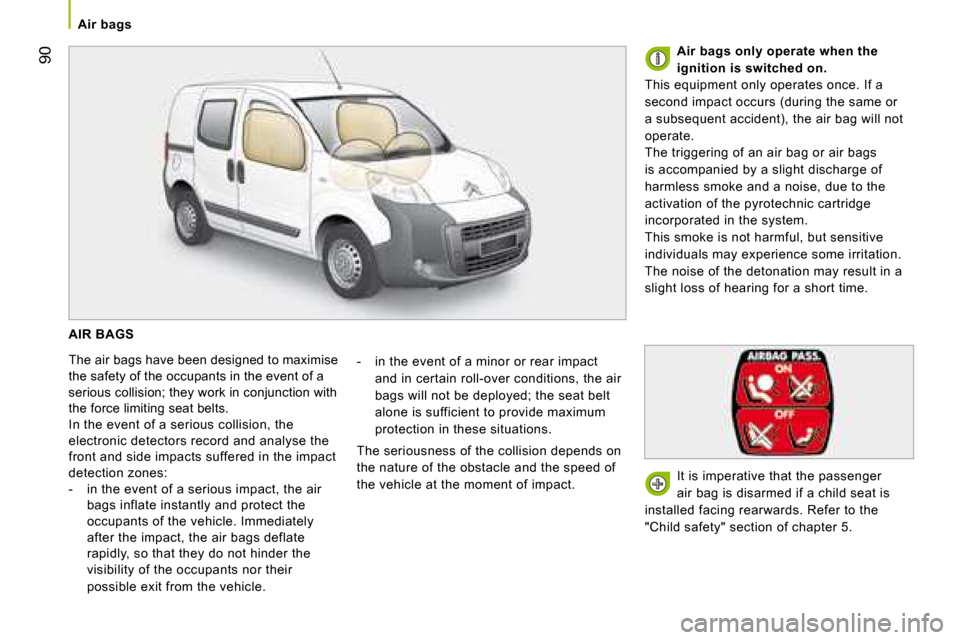
90
Air bags
AIR BAGS
The air bags have been designed to maximise the safety of the occupants in the event of a serious collision; they work in conjunction with the force limiting seat belts. In the event of a serious collision, the electronic detectors record and analyse the front and side impacts suffered in the impact detection zones:
- in the event of a serious impact, the air bags inflate instantly and protect the occupants of the vehicle. Immediately after the impact, the air bags deflate rapidly, so that they do not hinder the visibility of the occupants nor their
possible exit from the vehicle.
- in the event of a minor or rear impact
and in certain roll-over conditions, the air
bags will not be deployed; the seat belt
alone is sufficient to provide maximum
protection in these situations.
The seriousness of the collision depends on
the nature of the obstacle and the speed of
the vehicle at the moment of impact.
Air bags only operate when the
ignition is switched on.
This equipment only operates once. If a
second impact occurs (during the same or
a subsequent accident), the air bag will not
operate.
The triggering of an air bag or air bags
is accompanied by a slight discharge of
harmless smoke and a noise, due to the
activation of the pyrotechnic cartridge
incorporated in the system.
This smoke is not harmful, but sensitive
individuals may experience some irritation.
The noise of the detonation may result in a
slight loss of hearing for a short time.
It is imperative that the passenger
air bag is disarmed if a child seat is
installed facing rearwards. Refer to the
"Child safety" section of chapter 5.
Page 116 of 140

106
Battery
The batteries contain harmful
substances such as sulphuric acid and
lead. They must be discarded in accordance
with the provisions of the law and must not,
in any circumstances, be discarded with
household waste.
Take used batteries to a special collection
point.
Before disconnecting the battery, you must
wait for 2 minutes after switching off the
ignition.
Never disconnect a terminal when the
engine is running.
Never charge a battery without first
disconnecting the terminals.
Close the windows and doors before
disconnecting the battery.
After every reconnection of the battery,
switch on the ignition and wait 1 minute
before starting to allow the electronic
systems to be initialised. If slight difficulties
are experienced after this, please consult a
CITROËN dealer . It is advisable to disconnect the battery
if the vehicle is not to be used for a
period of more than one month.
If the battery has been disconnected
for some time, it may be necessary to
reinitialise the following functions:
- the display parameters (date, time, language, distance unit and temperature
unit),
- the radio stations,
- the central locking.
Some settings are cleared and must be
reprogrammed, consult a CITROËN dealer .
Page 117 of 140
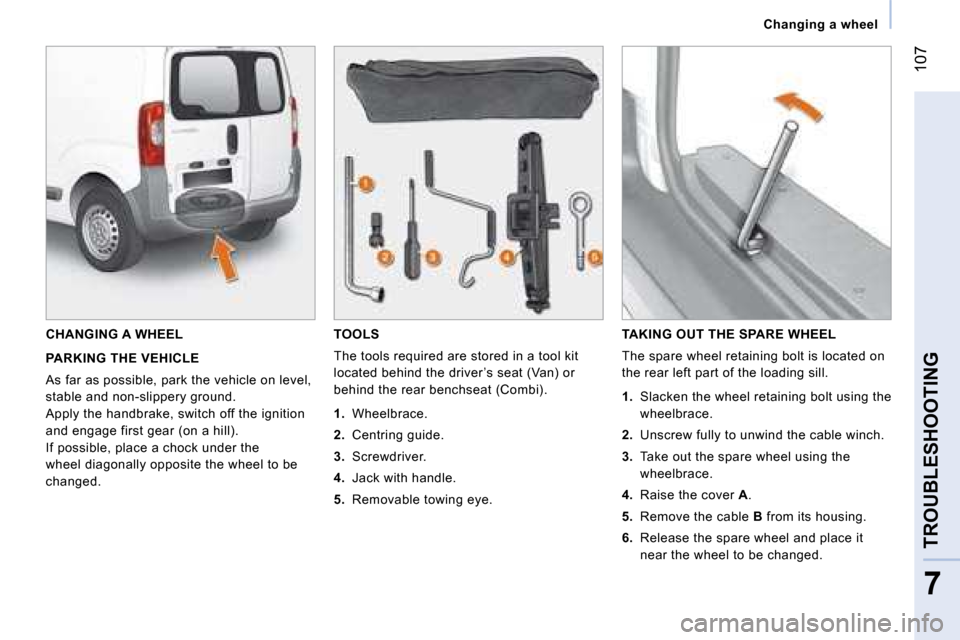
107
7
TROUBLESHOOTING
Changing a wheel
CHANGING A WHEEL
PARKING THE VEHICLE
As far as possible, park the vehicle on level,
stable and non-slippery ground.
Apply the handbrake, switch off the ignition
and engage first gear (on a hill).
If possible, place a chock under the
wheel diagonally opposite the wheel to be
changed.
TOOLS
The tools required are stored in a tool kit
located behind the driver ’s seat (Van) or
behind the rear benchseat (Combi).
1. Wheelbrace.
2. Centring guide.
3. Screwdriver.
4. Jack with handle.
5. Removable towing eye.
TAKING OUT THE SPARE WHEEL
The spare wheel retaining bolt is located on
the rear left part of the loading sill.
1. Slacken the wheel retaining bolt using the
wheelbrace.
2.
Unscrew fully to unwind the cable winch.
3. Take out the spare wheel using the
wheelbrace.
4. Raise the cover A .
5. Remove the cable B from its housing.
6. Release the spare wheel and place it
near the wheel to be changed.
Page 118 of 140
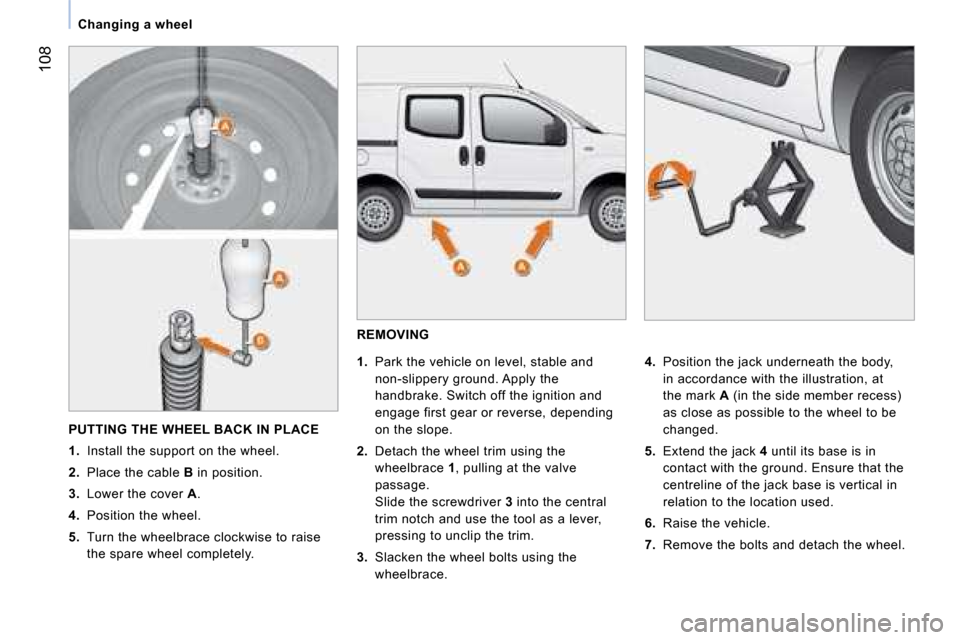
108
Changing a wheel
REMOVING
1. Park the vehicle on level, stable and
non-slippery ground. Apply the
handbrake. Switch off the ignition and
engage first gear or reverse, depending
on the slope.
2.
Detach the wheel trim using the
wheelbrace 1, pulling at the valve
passage.
Slide the screwdriver 3 into the central
trim notch and use the tool as a lever,
pressing to unclip the trim.
3. Slacken the wheel bolts using the
wheelbrace.
4. Position the jack underneath the body,
in accordance with the illustration, at
the mark A (in the side member recess)
as close as possible to the wheel to be
changed.
5. Extend the jack 4 until its base is in
contact with the ground. Ensure that the
centreline of the jack base is vertical in
relation to the location used.
6. Raise the vehicle.
7. Remove the bolts and detach the wheel.
PUTTING THE WHEEL BACK IN PLACE
1. Install the support on the wheel.
2. Place the cable B in position.
3. Lower the cover A .
4. Position the wheel.
5. Turn the wheelbrace clockwise to raise
the spare wheel completely.
Page 128 of 140
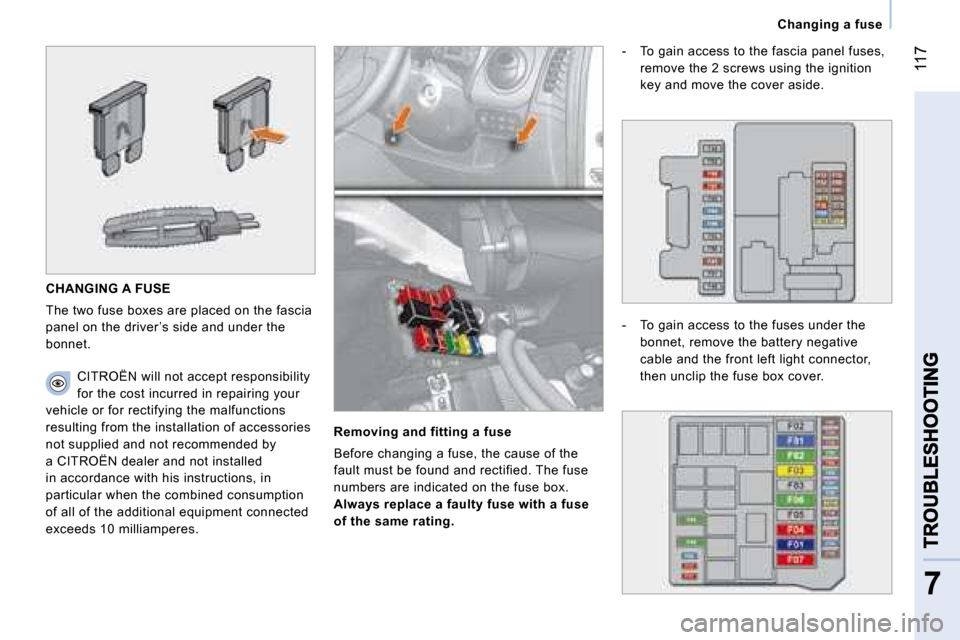
117
7
Changing a fuse
CHANGING A FUSE
The two fuse boxes are placed on the fascia
panel on the driver ’s side and under the
bonnet.
Removing and fitting a fuse
Before changing a fuse, the cause of the
fault must be found and rectified. The fuse
numbers are indicated on the fuse box.
Always replace a faulty fuse with a fuse
of the same rating. - To gain access to the fascia panel fuses,
remove the 2 screws using the ignition
key and move the cover aside.
- To gain access to the fuses under the bonnet, remove the battery negative
cable and the front left light connector,
then unclip the fuse box cover.
CITROËN will not accept responsibility
for the cost incurred in repairing your
vehicle or for rectifying the malfunctions
resulting from the installation of accessories
not supplied and not recommended by
a CITROËN dealer and not installed
in accordance with his instructions, in
particular when the combined consumption
of all of the additional equipment connected
exceeds 10 milliamperes.